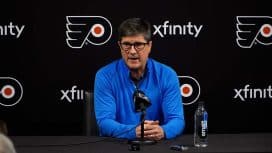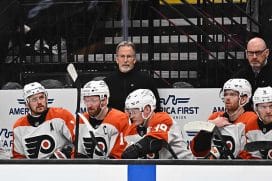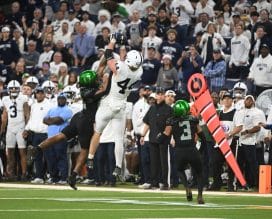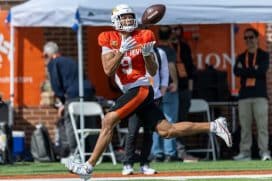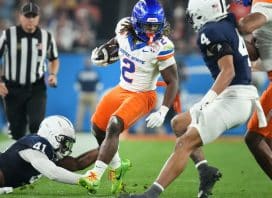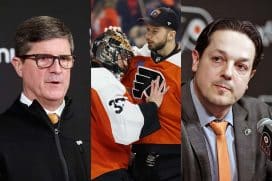Phillies
Average in the Outfield: A Look at the Current State of the Phillies Outfielders
By Siobhan Nolan, Sports Talk Philly Contributing Writer
If the Phillies infield was not a pressing matter, as we established in last week’s article, the outfield might be considered even less so. It’s getting a bit repetitive to say that an aspect of the Phillies team this past season was “mediocre at best”, but that is the unfortunate reality of this current team. And just like the infield, there are plenty of questions as to how to strategically arrange this outfield in order to get the best results of our defense.
Let’s begin at left field, where Andrew McCutchen mercifully was able to play after suffering a devastating ACL injury last season. While it was promising that McCutchen was able to get back on the field, it seemed as though his defensive abilities didn’t fully follow him there. No errors in 47 chances was the highlight of his defense this past season, but other than that, his performance was fairly forgettable. Did the major knee injury affect his performance? Most likely. Did his offensive performance make up for what he lacked in the field? Not really. McCutchen went 1 for 18 in his first few games of 2020, but had three multi-hit games over the next nine. Although it took him 17 games to hit his first home run of the season, he managed to hit safely in the next 12 out of 14 games (including seven multi-hit games), and was batting .261 by the end of August. Finishing the season with a .253 average, 10 home runs, and 34 RBIs isn’t spectacular, but right now, the Phillies don’t have many options when it comes to a left fielder or a leadoff hitter, making Cutch invaluable although admittedly average right now.
This brings us to right field, where Bryce Harper shines defensively. He’s a force to be reckoned with in his tried-and-true position, along with being one of the better offensive performers this season, but even Harper wasn’t exempt from setbacks. He started off 2020 incredibly strong, but did so at a pace that simply wasn’t sustainable. He suffered several dips in performance, many of which can be attributed to a back injury that Joe Girardi admitted started “four to five weeks” before it was public knowledge. Girardi acknowledged that in a regular 162-game season, Harper might have been temporarily shut down to get treated and recover, but this 60-game season didn’t allow that kind of time, forcing him to play when he wasn’t at 100% fitness. Despite the injury, Harper finished with a .268 average, with 13 home runs and 33 RBIs, making him one of the less frustrating players in the lineup.
Then, there’s center field, which is another position where the Phillies lack a player able to play consistently. There’s several options as to who should be the everyday center field, but none of them spark feelings of security in Phillies fans. The first option is Adam Haseley, who had a promising 2019 season, but regressed in basically all aspects of his game in 2020. Girardi’s plan from the get-go was to have Haseley platoon at center with Roman Quinn, but it became evident that the skipper preferred Quinn, giving him 28 starts to Haseley’s 18. Even when the outfield depth was seriously depleted, not much faith was shown in Haseley’s ability to play center. Case and point: an injured Bryce Harper was played in center field over Haseley against the New York Mets in September. Some argue that Haseley been given ample opportunity to shine (seeing as he was rather hurriedly called up from the minors last year), but there is plenty of reasonable doubt over Haseley’s abilities in center field.
A second option in center would be the aforementioned Roman Quinn, but he’s not much more promising than Haseley. The literal fastest man in baseball obviously has speed as a valuable quality, but he also spends quite a bit of time on the injured list. His inability to properly play balls off the wall and tendency to dive when he should let balls drop in front of him are faults that need to be improved upon, but it’s clear that Girardi prefers Quinn over Haseley in center field at the moment. It also helps that Quinn’s speed on the base paths makes him preferable to Haseley in the batting lineup, along with the fact that there seems to be some sort of unspoken consensus that Haseley can’t hit against left-handed pitchers. Either way, Quinn is a bit of a dark horse player that still has plenty to prove, but it looks as though he’s the man Girardi prefers in center field.
Technically a third option would be Scott Kingery, although his only real qualification for this position is that he spent much of his time under Gabe Kapler in center field. It’s unlikely that he’ll feature there much, as Girardi intends to keep Kingery at second base, or at least somewhere in the field. (And honestly, we might be better off forcing Shane Victorino out of retirement than having Kingery be the everyday CF. He’s just not an outfielder.)
Much like the infield’s issues, the outfield’s problems are not a matter of life and death. There needs to be more depth in the outfield, along with a player who can consistently play well at center, but there are plenty of silver linings. Haseley and Quinn are both fairly young players who have plenty of potential, and could benefit from some healthy competition to play center. Harper has 11 years left on his contract, and has been nothing short of exemplary in right field.
There just might be some hope for the Phillies defense after all.
